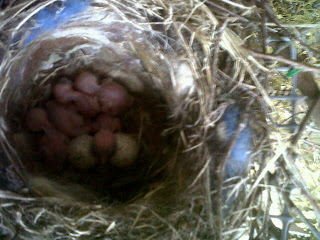Our 4 pairs of shrikes have been sitting tight incubating their eggs for the past 16 -18 days which was very sensible of them since we narrowly avoided 2 hurricanes in one week! Thankfully no nests or birds were harmed and the gusty winds and heavy rains are starting to settle down again. The shrike nests are checked a few days after the expected hatch date to ensure the chicks have hatched, are healthy and for a fledging date to be estimated. On checking the first nest due to have hatched I found 5 hatched chicks plus 2 eggs which. The first nest check for this nest revealed only 5 eggs so the extra 2 were a nice surprise. The hatchlings appeared about 1 day old and hopefully their unhatched siblings are not far behind them.
It will be just over 2 and a half weeks until the first chicks begin to branch out and explore outside of the nest. Then the number of birds in my care will drastically increase and the fun really begins!
One of our pairs showed no signs of nest making or courting so we swapped the female in hope that the male would take more interest this time around. Once caught, handling is kept to a minimum to reduce stress but we just had time to take a quick shot of the female who will be leaving us and returning to Toronto Zoo. She will most fondly be remembered for her ability to catch and impale wild snakes and beetles which always made the morning feed round more interesting.
I've nearly tripped over a few snakes in the past few weeks, since Canada's only venomous snake is the Mississauga rattler - easily identified by it's rattle- I thought Id take the opportunity to improve my snake handling skills. So here are a some snakes I managed to get a few shots of.
Eastern Gartersnake (Thamnosis sirtalis sirtalis)
Found in a range of habitats, gartersnakes are common throughout Ontario and can reach 1 meter in length. At a glance a young garter snake can be confused with Butler's Gartersnake (Thamnosis butleri), a threatened species also possessing 3 whitish stripes. The Eastern garternsnake can be identified by a scale count, the lateral white stripes being confined to the second and third scale rows.
Eastern milk snake (Lampropeltis triangulum)

Milksnakes have a similar pattern and colour as the Missasauga rattler and like this individual did, will often vibrate their tail in rattle-like fashion. Found in fields, rocky outcrops and rural habitats, this snake earned its name from the false belief that it drank the milk of the cows in the barns it resided in. In reality they much prefer eating mice.
I spent my time off at my cousins cottage again. We took a canoe trip down Eel Creek where we took on a lot of water and almost capsized. We portaged around 4 large rapids, risking 3 other sections where we grounded the boat on a large rock but stayed afloat none the less.
This white-spotted sawyer beetle (Monochamus scutellatus) was hanging out on the deck this afternoon. Initially my cousin Bridget went to squish it thinking it was the invasive and highly destructive Asian longhorn beetle that attacks conifers. This species however is a common wood-boring beetle found throughout North America, so we left him alone to do his thing.
So the next few weeks will be filled with lots of baby birds. One week after fledging they will begin their live mouse training where they learn to behave like wild shrikes and feed for themselves.
Life at the cabin is pretty relaxed and the sunsets are rarely disappointing.
At dusk a few days ago, our Field Biologist Hazel called me over to witness the unusually large moon rising.










.JPG)






